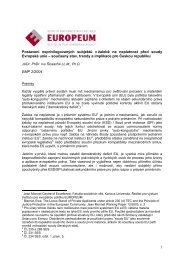eu constitutionalisation - EUROPEUM Institute for European Policy
eu constitutionalisation - EUROPEUM Institute for European Policy
eu constitutionalisation - EUROPEUM Institute for European Policy
Create successful ePaper yourself
Turn your PDF publications into a flip-book with our unique Google optimized e-Paper software.
Chapter 4: Government Coalitions and Institutional Re<strong>for</strong>m at the IGCposition of an elected President.¹³ The final outcome on both issuesclearly shows that although smaller states ‘lost’ on both points, the effectof their coalitional ef<strong>for</strong>t was, nevertheless, visible. The reduction of theCommission to two thirds of member states represented would take placeonly as of 2014, and this provision could be changed by the Councilacting by unanimity.¹⁴ In addition, a declaration was attached guaranteeingequal rotation among the member states ensuring geographical anddemocratic balance. Large states did, however, get an increased numberof Vice-Presidents (whom it was assumed would predominantly comefrom the large states). The new post of an elected President was agreedupon, but only <strong>for</strong> the <strong>European</strong> Council, and not <strong>for</strong> the Council ofMinisters <strong>for</strong>mations, where the rotating presidency would still apply.Furthermore, the president’s competencies were narrowly limited so asnot to overpower the role of the Commission President, whose status wasaccordingly upgraded.(2) Among the institutional provisions concerning the balance of powerbetween member states and EU institutions, the question of the extensionof the scope of the use of QMV (and correspondingly the co-decisionprocedure) was the most contested. While, as in past treaty re<strong>for</strong>ms, therewere a number of ‘maximalist’ states which argued <strong>for</strong> a substantive extensionof the procedure in order to retain the efficiency of decision-makingin the enlarged Europe, almost every member state had some ‘red lines’ inthe <strong>for</strong>m of areas in which unanimity should be retained. The coalitionalpatterns in this area were much more diffused than in the question of distributionof power. The UK had prominently announced its ‘red lines’ inthe areas of defence policy, tax harmonisation, social security rights and‘own resources’, in addition to treaty re<strong>for</strong>ms.¹⁵ However, unlike in thepast, it was not alone on these points. For example, Estonia and Cypruswere also firm proponents of unanimity in the area of tax harmonisation,and so, among older members, were Ireland, Sweden and Luxembourg.Denmark also as usual sought to retain unanimity in the area of socialpolicy and ‘own resources’. Differences on these points occurred even13) Birklbauer (2004). See also the Franco-German proposal on the re<strong>for</strong>m of institutions tabled to theConvention (CONV 489/03).14) See ‘Treaty Establishing a Constitution <strong>for</strong> Europe, as approved by the Intergovernmental Conference on18 June 2004’.15) See ‘A Constitutional Treaty <strong>for</strong> the EU. The British Approach to the <strong>European</strong> Union IntergovernmentalConference’ (2003).104Chapter 4: Government Coalitions and Institutional Re<strong>for</strong>m at the IGCwithin stable coalitions, such as France-Germany (on <strong>for</strong>eign and defencepolicy) and the Benelux countries (where Belgium was more in favour ofextension of QMV to Justice and Home Affairs, tax harmonisation andsocial and economic policy and health policy, than either Luxembourgor the Netherlands). Thus the Italian Presidency (in 2003) and IrishPresidency (in 2004) that coordinated the IGC adopted a strategy of breaking-upcoalitions on these issues in order to be able to trade concessionsacross individual issues. What we could see in this area was a plethora ofissue-by-issue coalitions defending a ‘minimalist’ position on one or a fewissues. The outcome of the IGC was an extension of the use of QMV in 44policy areas, as compared to the provisions currently in place.¹⁶ However,the traditionally sensitive areas of <strong>for</strong>eign and defence policy, social andtax policy and multi-annual financial framework would remain subject tounanimity voting.In summary, the outcome of the 2003/04 IGC negotiations on the institutionalprovisions clearly carries imprints of the action of various memberstate coalitions. Most of the coalitions had already emerged in the prenegotiationphase of the Convention on the Future of Europe, and indeedmany had existed also during the past institutional re<strong>for</strong>ms leading tothe Treaty of Amsterdam and the Treaty of Nice. Although, this article refersto all examples of concerted action among groups of member states as‘coalitions’, there are clearly also substantial differences among them. Thisarticle seeks to explain what the key characteristics of these coalitions were,whether we can typologise them, and how we can explain the governments’key motives behind the particular pattern of coalitions that occurred. Thearticle proceeds in two steps. The following section presents the analyticalframework used <strong>for</strong> answering these questions. First, the section drawsobservations from negotiation theory on the characteristics of coalitionsand coalitional choices. Second, four explanations of coalition-patterns inEU negotiations are derived from rationalist and constructivist scholarship,inspired by studies of coalitional patterns in EU legislative processes byElgström et all; Mattila; and Selck and Keating.¹⁷ The final section analyseseach of the coalitions in turn, highlighting their characteristics and assessingthe explanatory potential of the four different explanations of the coalitionpatterns <strong>for</strong> the present case study.16) Wessels (2004).17) Elgström et al (2001); Kaeding and Selck (2005); Mattila (2004).105








